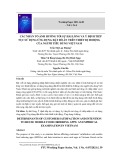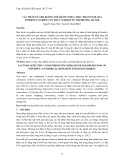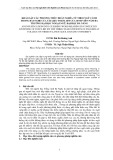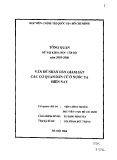
Goldsmith et al. Health and Quality of Life Outcomes 2010, 8:54
http://www.hqlo.com/content/8/1/54
Open Access
RESEARCH
© 2010 Goldsmith et al; licensee BioMed Central Ltd. This is an Open Access article distributed under the terms of the Creative Com-
mons Attribution License (http://creativecommons.org/licenses/by/2.0), which permits unrestricted use, distribution, and reproduc-
tion in any medium, provided the original work is properly cited.
Research
Mapping of the EQ-5D index from clinical outcome
measures and demographic variables in patients
with coronary heart disease
Kimberley A Goldsmith*
1,2,3
, Matthew T Dyer
4,5
, Martin J Buxton
4
and Linda D Sharples
1,2
Abstract
Background: The EuroQoL 5D (EQ-5D) is a questionnaire that provides a measure of utility for cost-effectiveness
analysis. The EQ-5D has been widely used in many patient groups, including those with coronary heart disease. Studies
often require patients to complete many questionnaires and the EQ-5D may not be gathered. This study aimed to
assess whether demographic and clinical outcome variables, including scores from a disease specific measure, the
Seattle Angina Questionnaire (SAQ), could be used to predict, or map, the EQ-5D index value where it is not available.
Methods: Patient-level data from 5 studies of cardiac interventions were used. The data were split into two groups -
approximately 60% of the data were used as an estimation dataset for building models, and 40% were used as a
validation dataset. Forward ordinary least squares linear regression methods and measures of prediction error were
used to build a model to map to the EQ-5D index. Age, sex, a proxy measure of disease stage, Canadian Cardiovascular
Society (CCS) angina severity class, treadmill exercise time (ETT) and scales of the SAQ were examined.
Results: The exertional capacity (ECS), disease perception (DPS) and anginal frequency scales (AFS) of the SAQ were
the strongest predictors of the EQ-5D index and gave the smallest root mean square errors. A final model was chosen
with age, gender, disease stage and the ECS, DPS and AFS scales of the SAQ. ETT and CCS did not improve prediction in
the presence of the SAQ scales. Bland-Altman agreement between predicted and observed EQ-5D index values was
reasonable for values greater than 0.4, but below this level predicted values were higher than observed. The 95% limits
of agreement were wide (-0.34, 0.33).
Conclusions: Mapping of the EQ-5D index in cardiac patients from demographics and commonly measured cardiac
outcome variables is possible; however, prediction for values of the EQ-5D index below 0.4 was not accurate. The newly
designed 5-level version of the EQ-5D with its increased ability to discriminate health states may improve prediction of
EQ-5D index values.
Background
The EuroQoL 5D (EQ-5D) is a widely used generic mea-
sure of health related quality of life (HRQoL) and can be
used to generate a single index value or utility [1-3]. This
utility value is used for the calculation of quality-adjusted
life years (QALYs) for cost-effectiveness analysis. The
EQ-5D is currently recommended by the UK's National
Institute for Health and Clinical Excellence (NICE) as a
tool for quantifying utility in adults [3,4]. Quality of life
and cost-effectiveness analyses are important for trials of
interventions in cardiac patients and the EQ-5D has been
used to calculate QALYs for cost-effectiveness analyses in
several such trials [5-9].
Patients participating in clinical trials and other studies
often have to complete many questionnaires, sometimes
at multiple points in time. The EQ-5D is a short survey
that has been shown to have good acceptability and feasi-
bility in the general public and in cardiac patients [10-12].
However, in many studies it may not have been adminis-
tered, for reasons of perceived patient burden from mul-
tiple questionnaires or because the study has not initially
focused on economic questions. With the growing
importance of cost-effectiveness estimation to inform
* Correspondence: kimberley.goldsmith@kcl.ac.uk
1 Papworth Hospital NHS Trust, Cambridge, UK
Full list of author information is available at the end of the article






























